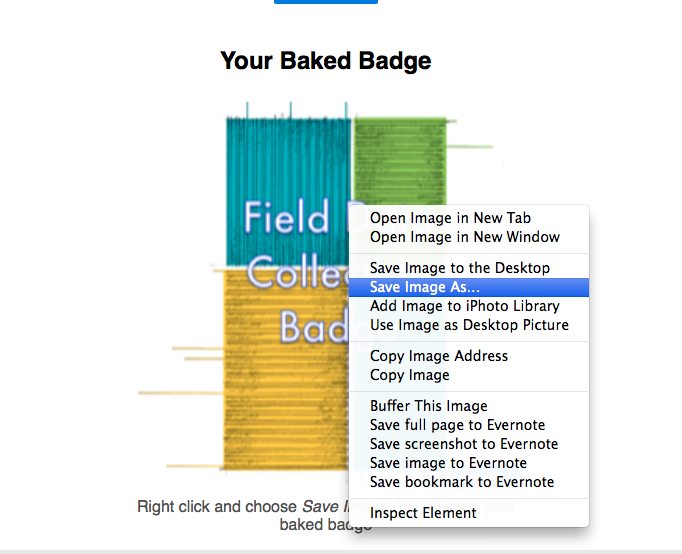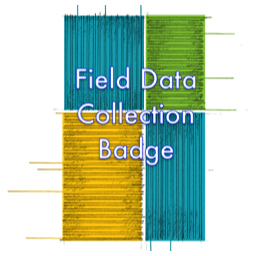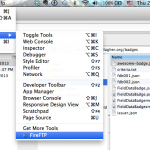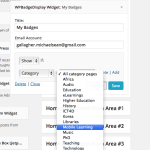Open Badges: Why and Why Not
I have been wanting for some time now to learn how to make and issue open badges as I have been conducting workshops and other research projects over the years where some sort of alternative accreditation of learning would have been beneficial. I am thinking mostly along the lines of informal learning (more specifically, lifelong learning) where learners could by some mechanism demonstrate that they are investing in their own learning outside of a formal organizational structure.
I know of the advantages and disadvantages of such an approach, the broader political and economic issues involved, and the (perceived) cheapening of education that some view a natural result of this activity. I don’t inherently embrace or disown any of those perspective, but I do feel as though it is our job as learning professionals to explore every avenue for learning that is presented to us. I also feel it is our duty to make it clear that learning is always a mediation between tools, content, and intent. If before it was diplomas, parchment, insignias, pencils, and papers, then I am perfectly happy to state that now it might be badges, code, and pngs. All of this might be appropriated by business and made profitable (and thus creating a hierarchy of access); all of this might be disowned by academia and forever given the (open) badge of shame to carry with it like a curse. I am speaking in hyperbole, obviously. Academically and from a research perspective, open badges are a complex amalgamation of so much cultural, political, and economic capital (and therefore interesting as a research subject). Pragmatically, they allow me to extend my teaching (and hopefully my students’ learning) well beyond any sort of formal educational structure. This post, that long preamble aside, is about this latter pragmatism. How do I make and issue badges?
Open Badges: How
Smaller preamble: I have smart(er) friends (than me). One such friend is David Fox, with whom I worked together with both here and here. He knows things, he does things, he writes things. Many things. So I turned to him as I couldn’t quite get my head around how one made and issued badges. He put his ample intellect to it and so what I relay here is mostly (almost exclusively) his doing. Hopefully it is worthwhile to some of you. In later posts, I will start outlining how I plan to use these badges as I have already documented ten of them. I will give you a hint: it rhymes with lobile mearning. I suspect my colleague Pekka and I can use these for upcoming field activity workshops we will be conducting. I suspect I can use these in Korea and in another project I am about to kick off elsewhere.
Again, let me emphasize that what follows is mostly his doing (even his writing). But I thought it might be useful to my audience. First what you need followed by how you need to do it.
What You Need
- Somewhere to host files (I use my ftp from my self-hosted WordPress site). I think it is possible to do it all from Dropbox, though. The FTP client I use is a Firefox add-on called (see screenshot below) called FireFTP
- One folder on that FTP (mine is ably called Open Badges).
- One Issuer file (a file saved as .json which says who I am as an issuing organization)
- One Criteria file (a file saved as .txt which outlines what the person has to do to get this badge-the learning activities)
- One Assertion file (a file saved as .json that outlines who is receiving the badge, what badge they are receiving, etc).
- One Badge image (a .png file of whatever image you want the badge to be)
- One Badge file (a file saved as .json which identifies the fields of the badge itself and links back to these other files)
At the bottom of this post, as a sort of appendix, I have included the text I used for each of the files (and by “I have included” I mean I basically copied what Dave told me to say) as well as some of the sites that Dave found to help us along.
What You Need to Do
- Create your own Mozilla Backpack account. This is basically where you will host all your badges. It is easier to just do it at the beginning.
- Create the files as outlined above.
- Transfer them to the folder you created on your FTP.
- Copy the URL of the location of the Assertion file. It is in the file itself (or just right click on the file and click Properties)
- Go to either http://backpack.openbadges.org/baker?assertion= or http://bakery.openbadges.org/ and paste that Assertion URL there. (Dave kindly informed me this is called baking).
- Click Bake
- Once you see the badge, right click and Save as to save it locally.
- Go back to Mozilla Backpack and upload it to your backpack.
- Display badges earned on your site (with a plugin on WordPress if you like).
Some images below to visually represent some of this. On WordPress, the plugin I am using to display the badges allows you to show certain badges for certain categories or tags or pages. Quite useful if you want to only display a specific set of badges for prospective employers or researchers or what have you.
Resources
Again, Dave found these, but I wanted to pass them along as well in case anyone found this useful and wanted to try for themselves.
Tutorials
- http://badgelab.herokuapp.com/tutorial/59637
- https://blogs.cites.illinois.edu/cites-ats/2013/05/20/so-you-want-to-bake-some-badges/
Metadata Standards (what you can include in these files)
- https://github.com/mozilla/openbadges-specification/blob/master/Assertion/latest.md
Where to Bake the Badge
Files (What Information They Include)
Issuer.json
{
“name”: “Michael Gallagher”,
“description”: “mLearning, eLearning, and Digital Education”,
“email”: “michael@michaelseangallagher.org”,
“url”: “https://michaelseangallagher.org”
}
Criteria.txt
This badge is part of a series of badges dedicated to developing organizational capacity for mobile learning. This badge is earned by performing the following tasks:
1. Collection of five images of the selected locale.
2. Collection of one video of no less than 60 seconds at the selected locale.
3. Collection of one audio recording of no less than 60 seconds at the selected locale.
4. A text document listing an inventory of what data was collected and where.
5. A short blog reflection on the quality of the data being collected and initial assumptions about what it will reveal.
Assertion.json
{
“uid”: “uniqueid”,
“recipient”: {
“type”: “email”,
“hashed”: false,
“identity”: “email address of person who earned the badge”
},
“issuedOn”: “2014-06-29T01:52:34.676Z”,
“badge”: “URLofbadge.json”,
“verify”: {
“type”: “hosted”,
“url”: “URL of assertion.json”
}
}
Badge.json
{
“name”: “Field Data Badge”,
“description”: “This badge is part of a series of badges dedicated to developing organizational capacity for mobile learning.”,
“image”: “URL of badge.png”,
“criteria”: “URL of criteria.txt”,
“issuer”: “URL of issuer.json”
}








[…] Open Badges: Why and Why Not I have been wanting for so… […]
[…] Open Badges: Why and Why Not I have been wanting for so… […]
[…] Continuar leyendo: Open Badges: Why and How […]
[…] Open Badges: Why and Why Not I have been wanting for so… […]
[…] Open Badges: Why and Why Not I have been wanting for so… […]
[…] Open Badges: Why and Why Not I have been wanting for so… […]
[…] Open Badges: Why and Why Not I have been wanting for so… […]
[…] Open Badges: Why and Why Not I have been wanting for so… […]
[…] Open Badges: Why and Why Not I have been wanting for so… […]
[…] Open Badges: Why and Why Not I have been wanting for so… […]
[…] I have been wanting for some time now to learn how to make and issue open badges as I have been conducting workshops and other research projects over the years where some sort of alternative accreditation of learning would have been beneficial. I am thinking mostly along the lines of informal learning (more specifically, lifelong learning) where learners could by some mechanism demonstrate that they are investing in their own learning outside of a formal organizational structure. […]
[…] Open Badges: Why and Why Not I have been wanting for so… […]
[…] Open Badges: Why and Why Not I have been wanting for so… […]
[…] Open Badges: Why and Why Not I have been wanting for so… […]
[…] “Open Badges: Why and Why Not I have been wanting for so…” […]
[…] Open Badges: Why and Why Not I have been wanting for so… […]
[…] Open Badges: Why and Why Not I have been wanting for so… […]
[…] Open Badges: Why and Why Not I have been wanting for so… […]
[…] Open Badges: Why and Why Not I have been wanting for so… […]
[…] Open Badges: Why and Why Not I have been wanting for so… […]
[…] Open Badges: Why and Why Not I have been wanting for so… […]
[…] Open Badges: Why and Why Not I have been wanting for so… […]
[…] Open Badges: Why and Why Not I have been wanting for so… […]
[…] Open Badges: Why and Why Not I have been wanting for so… […]